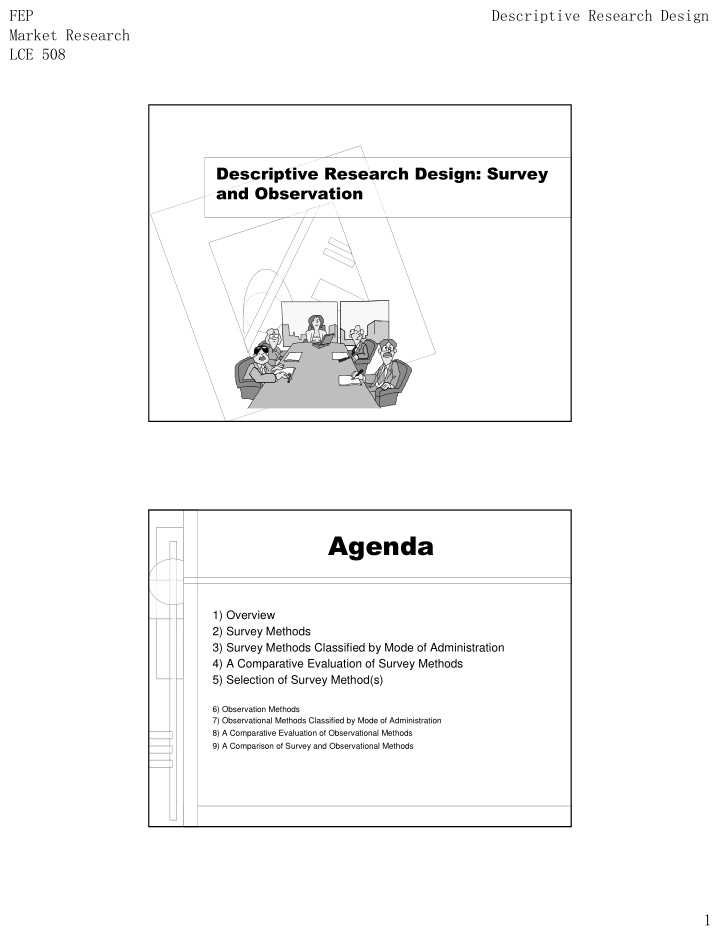



��� ��������������������������� ��������������� ������� ������������������������������������ ��������������� ������ 1) Overview 2) Survey Methods 3) Survey Methods Classified by Mode of Administration 4) A Comparative Evaluation of Survey Methods 5) Selection of Survey Method(s) 6) Observation Methods 7) Observational Methods Classified by Mode of Administration 8) A Comparative Evaluation of Observational Methods 9) A Comparison of Survey and Observational Methods �
��� ��������������������������� ��������������� ������� ������������� • A structured questionnaire given to respondents and designed to elicit specific information – based on the questioning of respondents – respondents are asked a variety of questions regarding their behavior, intensions, attitudes, awareness, motivations, and demographic and lifestyle characteristics – questions may be asked verbally, in writing or via computer ��������������������������� ������� ������� ������� ��������� �������� ���� ���������� ������������������ ����� ������� ������ �������� ��������� ��������� ������������ ������������������ ������������ ����� ����� ���������� ��������� ��������� ����� ������������ �
��� ��������������������������� ��������������� ������� ����������������� • Traditional Telephone Interviews – Involve phoning a sample of respondents and asking them a series of questions – The interviewer uses a paper questionnaire and records the responses with a pencil • Computer Assisted Telephone Interviews – Involve using a computerized questionnaire administered to respondents over the telephone – The computer systematically guides the interviewer (and replaces a paper and pencil questionnaire) ���������������� • Personal in-home interviews – Respondents are interviewed face-to-face in their homes – The interviewer's task is to contact the respondents, ask the questions and record the responses • Mall intercept interviews – Respondents are intercepted while they are shopping in malls and brought to test facilities un malls • Computer-assisted personal interviews – The respondent sits in front of a computer terminal and answers a questionnaire on the computer screen by using the keyboard or a mouse – And interviewer is usually present �
��� ��������������������������� ��������������� ������� ������������ • Mail interviews – Questionnaires are mailed to pre selected potential respondents – A typical mail interview package consists of: • The outgoing envelop, cover letter, questionnaire, return envelope, and possible an incentive • The respondents complete and return the questionnaire (there is no verbal interaction between the researcher and the respondent) • Mail Panels – A large and nationally representative sample of households who have agreed to periodically participate in mail questionnaires and product tests ����������������� • E-mail interviews – A list of e-mail addresses is obtained – The survey is written within the body of the e-mail message – The e-mails are sent over the internet • Internet Interviews – Internet or web surveys are posted on a web site – Respondents are asked to go to a particular web location to complete the survey – Many times respondents who happen to be visiting the web site where the survey is posted are invited to participate in the survey �
��� ��������������������������� ��������������� ������� ������������������������������ �����!�������"����#��� ������������������ ����������������� ���!�"������"��������������� ������� ��������#����������� ������������ ����������� ������#������� ���������� ���������!����� ��������� ������������� $����� ��!� $����������%����� ������������������������ &������������������������������&������������������� ��������������� ������#������������� ������� ���������� ���������������������������� ������������������������������ ������������� ���������� �������������� �
��� ��������������������������� ��������������� ������� $��%���������������� ���������� Flexibility of Data Collection • The flexibility of data collection is determined primarily by the extent to which the respondent can interact with the interviewer and the survey questionnaire. – The personal interview (whether conducted in home or as mall intercept interview) allows the highest flexibility of data collection • Because the respondent and the interviewer meet face to face, the interviewer can administer complex questionnaires and explain and clarify difficult questions – Phone interviews allow only moderate flexibility • Its more difficult ask complex questions and obtain in-depth answers to open- ended questions over the telephone – Mail surveys, mail panels and e-mail surveys • Have low flexibility • These models do nor allow for interaction between the interviewer and the respondent – CATI, CAPI and Internet Surveys • The questionnaire is administered in an interactive way �������������&�������� Diversity of Questions • The diversity of questions that can be asked in a survey depends upon the degree of interaction the respondent has with the interviewer and the questionnaire, as well as the ability to actually see the questions. • Personal interviews – Respondents can see the questionnaire and the interviewer is present to clarify ambiguities – High diversity • Internet Surveys – Multimedia surveys can be utilized => the ability to ask a diversity of questions is moderate to high, despite the absence of an interviewer �
��� ��������������������������� ��������������� ������� '���������������������� Use of Physical Stimuli • The ability to use physical stimuli such as the product, a product prototype, commercials, or promotional displays during the interview. taste tests, photographs, maps, audiovisual cues �������������� Sample Control • Sample control is the ability of the survey mode to reach the units specified in the sample effectively and efficiently. • In-home personal interviews – Offer the best sample control: • Its possible to control which sampling units are interviewed, who is interviewed, the degree of participation of other members of the household, … �
Recommend
More recommend